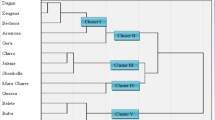Abstract
The interactions of four potato cultivars, with three isolates ofPhytophthora infestans were assessed in different environments and in different years. Preliminary tests with these cultivars and isolates were conducted in Toluca, Mexico, and Freeville, New York, U.S.A. in 1986 and 1987. Although data were available from only one year for cultivar Alpha, this cultivar had a dramatically different resistance ranking in Toluca, than that in Freeville — a result consistent with previous observations. The difference in resistance between two other cultivars also changed with site, but less dramatically and did not cause a change in resistance ranking. The resistance of the fourth cultivar appeared to be relatively unaffected by change in site. In both sites, all isolates ranked all cultivars in the same order. Although aggressiveness was slightly different in different locations and on different cultivars, variations were small and there were no consistent trends (consistent over all trials) concerning isolate aggressiveness. Thus, changes in location appeared to have different effects on the different cultivars but little or no effect on the isolates used.
Compendio
Las interacciones de cuatro cultivares de papa, con tres aislamientos dePhytophthora infestans, fueron determinadas en diferentes ambientes y años. Pruebas preliminares con estos cultivares y aislamientos se condujeron en Toluca, México y en Freeville, New York, EE.UU, en 1986 y 1987. No obstante que para el cultivar Alpha se contó sólo con información de un año, este cultivar tuvo una resistencia dramáticamente diferente en Toluca, en comparación con la observada en Freeville, un resultado que fue consistente con observaciones anteriores. La diferencia en resistencia entre los otros dos cultivares varió también con el lugar, pero fue menos dramática y no causó cambios en el orden de resistencia por ellos alcanzado. La resistencia del cuarto cultivar aparentemente no varió con el cambio de lugar. En ambos lugares, todos los aislamientos clasificaron a todos los cultivares en el mismo orden. Aunque la agresividad fue ligeramente diferente en los diferentes lugares y cultivares. Las variaciones fueron pequeñas y no existieron tendencias consistentes (consistentes en todos los ensayos) respecto a la agresividad de los aislamientos. Por lo tanto, el cambio de lugar parece tener efectos diferentes sobre los diferentes cultivares, pero poco o ningún efecto sobre los aislamientos utilizados.
Similar content being viewed by others
Literature Cited
Anonymous. 1947. The measurement of potato blight. Trans Br Mycol Soc 31:140-141.
Caten, C.E. 1974. Intra-racial variation in Phytophthora infestans and adaptation to field resistance for potato blight. Ann Appl Biol 77: 259–270.
Caten, C.E. and J.L. Jinks. 1968. Spontaneous variation of single isolates of Phytophthora infestans. I. Cultural variation. Can J Bot 46: 329–348.
Fry, W.E. 1978. Quantification of general resistance of potato cultivars and fungi cide effects for integrated control of potato late blight. Phytopathology 68: 1650–1655.
Gallegly, M.E. and J.S. Niederhauser. 1959. Genetic controls of host-parasite inter actions in the Phytophthora infestans late blight disease.In: Plant Pathology, Prob lems and Progress 1908–1958, C.S. Holton, et al. [Ed.]. U Wis Press, Madison. pp. 68–82.
Gees, R. and H.R. Hohl. 1988. Cytological comparison of specific (R3) and general resistance to late blight in potato leaf tissue. Phytopathology 78: 350–357.
James, R.V. and W.E. Fry. 1983. Potential for Phytophthora infestans populations to adapt to potato cultivars with rate-reducing resistance. Phytopathology 73: 984–988.
Jenns, A.E. and K.J. Leonard. 1985. Effects of temperature and illuminance on resis tance of inbred lines of corn to isolates of Bipolaris maydis. Phytopathology 75: 274–280.
Jenns, A.E., K.J. Leonard and R.H. Mill. 1982. Variation in the expression of speci ficity in two maize diseases. Euphytica 31: 269–279.
Latin, R.X., D.R. MacKenzie and H. Cole, Jr. 1981. The influence of host and patho gen genotypes on the apparent infection rates of potato late blight epidemics. Phytopathology 71: 82–85.
Niederhauser, J.S. and W.R. Mills. 1953. Resistance of Solanum species to Phytophthora infestans in Mexico. Phytopathology 43: 456–457.
Norwood, J.M., I.R. Crute and K. Phelps. 1984. Variation in seedling susceptibility to Bremia lactucae (lettuce downy mildew) in the absence of effective major resis tance genes. Ann Appl Biol 105: 147–157.
Parker, J.M. 1989. Stability of disease expression in the potato late blight pathosystem. Ph.D. Dissertation, Plant Pathology Department, Cornell University. Ithaca, NY. 141 pp.
Parlevliet, J.E. and J.C. Zadoks. 1977. The integrated concept of disease resistance, a new view including horizontal and vertical resistance in plants. Euphytica 26: 5–21.
Paxman, G.J. 1963. Variation in Phytophthora infestans. Eur Pot J 6(1)14–23.
Ribeiro, Olaf K. 1978. A source book of the genus. Phytophthora. J. Cramer.In: der A.R. Gantner Verlag Kommand. p. 75.
SAS-Institute, Inc. 1985. SAS-User’s Guide: Statistics, Version 5 Ed. Cary, N. Carolina: SAS-Institute, Inc. 956 pp.
Shaner, G. and R.E. Finney. 1977. The effect of nitrogen fertilization on the expres sion of slow-mildewing resistance in Knox wheat. Phytopathology 67: 1051–1056.
Tooley, P.W. 1988. Use of uncontrolled freezing for liquid nitrogen storage ofPhytophthora sp. Plant Disease 72: 680–682.
Tooley, P.W. and W.E. Fry. 1985. Field assessment of fitness of isolates of Phytophthora infestans. Phytopathology 75: 982–988.
Tschanz, A.T. 1978. Incorporation of resistance to Phytophthora infestans and Pseudotnonas solanacearum into the andigena potato and the interrelationship of Meloidogyne incognita and Pseudomonas solanacearum on potato resistant to Pseudomonas solanacearum. Ph.D. Thesis, Cornell University. 131 pp.
Umaerus, V. 1959. The relationship between peroxidase activity in potato leaves and resistance to Phytophthora infestans. Am Potato J 36: 124–131.
Author information
Authors and Affiliations
Rights and permissions
About this article
Cite this article
Parker, J.M., Thurston, H.D., Villarreal-Gonzalez, M.J. et al. Stability of disease expression in the potato late blight pathosystem: A preliminary field study. American Potato Journal 69, 635–644 (1992). https://doi.org/10.1007/BF02852676
Accepted:
Issue Date:
DOI: https://doi.org/10.1007/BF02852676




